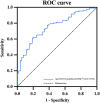Stroke-associated pneumonia with low PaO2/FiO2 ratio in acute large vessel occlusion after endovascular therapy: risk factors and prognosis
- PMID: 40823311
- PMCID: PMC12350393
- DOI: 10.3389/fneur.2025.1598156
Stroke-associated pneumonia with low PaO2/FiO2 ratio in acute large vessel occlusion after endovascular therapy: risk factors and prognosis
Abstract
Background: Stroke-associated pneumonia (SAP) often occurs after ischemic stroke. A deterioration in SAP manifests itself in a decreased partial pressure oxygen (PaO2)/fraction of inspired oxygen (FiO2) ratio, indicating gas exchange dysfunction. We aimed to investigate independent predictors and outcomes of SAP with low PaO2/FiO2 ratio among patients with acute large vessel occlusion (ALVO) undergoing endovascular therapy.
Methods: We retrospectively analyzed the prospective data of consecutive adult post-interventional patients with ALVO admitted to neuro-intensive care units in Wuhan No. 1 Hospital from December 2020 to December 2022. Patients developing SAP without coronavirus disease 2019 were included in this study and divided into two subgroups: PaO2/FiO2 ratio > 240 and ≤ 240. The primary outcome was favorable neuro-function at 90 days (modified Rankin Scale score of 0-2). Secondary outcomes included hospitalization days, occurrence of symptomatic intracerebral hemorrhage, and 90-day mortality. The independent risk factors and prognosis for SAP with PaO2/FiO2 ratio ≤ 240 were identified by logistic regression analyses.
Results: A total of 159 subjects developing SAP were included in this study: 53 with PaO2/FiO2 ratio > 240 and 106 with ratio ≤ 240. Compared to subjects with PaO2/FiO2 ratio > 240, those with PaO2/FiO2 ratio ≤ 240 had older ages, higher baseline National Institutes of Health Stroke Scales scores, larger proportions of baseline Glasgow Coma Scale (GCS) score of 3-8 and grade of kobuta water swallow test ≥ 3, higher white blood cell (WBC) counts (all p values <0.05). The independent predictors for SAP with PaO2/FiO2 ratio ≤ 240 included ages (adjusted odds ratio [OR], 1.043; 95% confidential interval [CI], 1.011-1.077; p = 0.009), baseline GCS scores of 3-8 (adjusted OR, 2.802; 95% CI, 1.214-6.465; p = 0.016), and ln-transformed WBC counts after SAP diagnosis (adjusted OR, 3.977; 95% CI, 1.226-12.896; p = 0.021). SAP with PaO2/FiO2 ratio ≤ 240 was robustly associated with longer hospitalization days (adjusted OR, 1.074; 95% CI, 1.01-1.143; p = 0.024).
Conclusion: SAP with PaO2/FiO2 ratio ≤ 240 is shown in significant relevance to the prolonged in-hospital stays among post-interventional patients. Older ages, baseline GCS scores of 3-8, and higher WBC counts after SAP diagnosis can independently predict the occurrence of SAP with a lower PaO2/FiO2 ratio. Further validation studies are needed.
Keywords: PaO2/FiO2 ratio; endovascular therapy; ischemic stroke; prognosis; risk factor; stroke-associated pneumonia.
Copyright © 2025 Tang, Li, Wang, Guo, Yang, Guo, Cai and Liu.
Conflict of interest statement
The authors declare that the research was conducted in the absence of any commercial or financial relationships that could be construed as a potential conflict of interest.
Figures



Similar articles
-
Higher versus lower fractions of inspired oxygen or targets of arterial oxygenation for adults admitted to the intensive care unit.Cochrane Database Syst Rev. 2023 Sep 13;9(9):CD012631. doi: 10.1002/14651858.CD012631.pub3. Cochrane Database Syst Rev. 2023. PMID: 37700687 Free PMC article.
-
High-flow nasal cannulae for respiratory support in adult intensive care patients.Cochrane Database Syst Rev. 2017 May 30;5(5):CD010172. doi: 10.1002/14651858.CD010172.pub2. Cochrane Database Syst Rev. 2017. Update in: Cochrane Database Syst Rev. 2021 Mar 4;3:CD010172. doi: 10.1002/14651858.CD010172.pub3. PMID: 28555461 Free PMC article. Updated.
-
Endovascular thrombectomy with versus without intravenous thrombolysis for acute ischaemic stroke.Cochrane Database Syst Rev. 2025 Apr 24;4(4):CD015721. doi: 10.1002/14651858.CD015721.pub2. Cochrane Database Syst Rev. 2025. PMID: 40271574
-
[Predictive value of plasma exosome count for the prognosis in septic patients].Zhonghua Wei Zhong Bing Ji Jiu Yi Xue. 2024 Jul;36(7):687-692. doi: 10.3760/cma.j.cn121430-20230717-00529. Zhonghua Wei Zhong Bing Ji Jiu Yi Xue. 2024. PMID: 39223881 Chinese.
-
Efficacy and safety of nerinetide in acute ischaemic stroke in patients undergoing endovascular thrombectomy without previous thrombolysis (ESCAPE-NEXT): a multicentre, double-blind, randomised controlled trial.Lancet. 2025 Feb 15;405(10478):560-570. doi: 10.1016/S0140-6736(25)00194-1. Lancet. 2025. PMID: 39955119 Clinical Trial.
References
LinkOut - more resources
Full Text Sources
Miscellaneous

